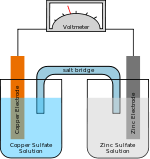Edison-Lalande cell

The Edison-Lalande cell was a type of alkaline primary battery developed by Thomas Edison from an earlier design by Felix Lalande and Georges Chaperon.[1][2] It consisted of plates of copper oxide and zinc in a solution of potassium hydroxide. The cell voltage was low (about 0.75 volts) but the internal resistance was also low so these cells were capable of delivering large currents.[3]
History
Lalande-Chaperon cell
In 1880, the manufacturer De Branville and Company of 25 rue de la Montagne Sainte-Geneviève, Paris exploited the patent of Lalande and Chaperon to build copper oxide batteries.[4] In 1887, the French submarine Gymnote (Q1) was built. The boat was originally fitted with 540 Lalande-Chaperon alkaline cells which used zinc and copper oxide electrodes with potassium hydroxide electrolyte, manufactured by Coumelin, Desmazures and Baillache.
Edison-Lalande cell
Edison improved on the Lalande-Chaperon cell by replacing powdered copper oxide with copper oxide briquettes.
Poerscke-Wedekind cell
Another modification to the Lalande-type cell was patented by Heinrich Poerscke and Gustav Wedekind in 1905, British patent GB190416751.[5] In this cell, the copper oxide depolarizer was pasted on the inside of a cast iron pot. When the depolarizer was exhausted, the cell was dismantled and the liquid was poured out. The pot was then heated in air to re-oxidize the deposited copper to copper oxide. The Neotherm cell, by Siemens, was similar.[6][7]
Chemistry
The zinc dissolves in the hydroxide solution to form zincate, consuming hydroxide in the process.
Zn0 + 4OH- -> [Zn(OH4)]2- + 2e-
half of the hidroxides are repleished by the hidrationand reduction of the copper oxide.
CuO + H2O + 2e- -> Cu0 + 2OH-
Applications
Applications for Lalande-type batteries included submarine power (see above), railway signalling.[8] and powering Edison's electric fans and phonographs.[9]
References
- ↑ "Location Text and List of Documents - The Edison Papers". Edison.rutgers.edu. Retrieved 2013-06-12.
- ↑ "Storage Battery - The Edison Papers". Edison.rutgers.edu. 2012-02-20. Retrieved 2013-06-12.
- ↑ Ayrton, W.E. and Mather, T. Practical Electricity, Cassell and Company, London, 1911, pp 196-197
- ↑ "Les Piles Lalande et Chaperon". Dspt.perso.sfr.fr. Retrieved 2013-06-12.
- ↑ "Espacenet - Bibliographic data". Worldwide.espacenet.com. Retrieved 2013-06-12.
- ↑ http://archive.org/stream/electricaljourna63lond/electricaljourna63lond_djvu.txt
- ↑ http://www.ebooksread.com/authors-eng/arthur-john-allmand/the-principles-of-applied-electrochemistry-hci/page-20-the-principles-of-applied-electrochemistry-hci.shtml
- ↑ "A Short History of Ancient Electricity". Bibliotecapleyades.net. Retrieved 2013-06-12.
- ↑ "Edison Type S Battery Set". Edisontinfoil.com. Retrieved 2013-06-12.
